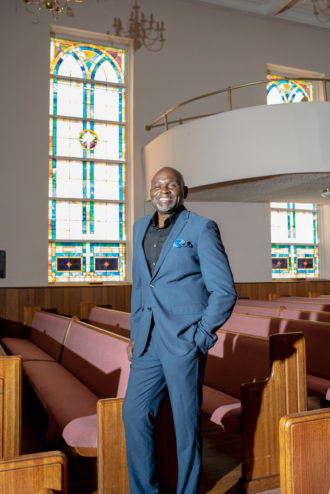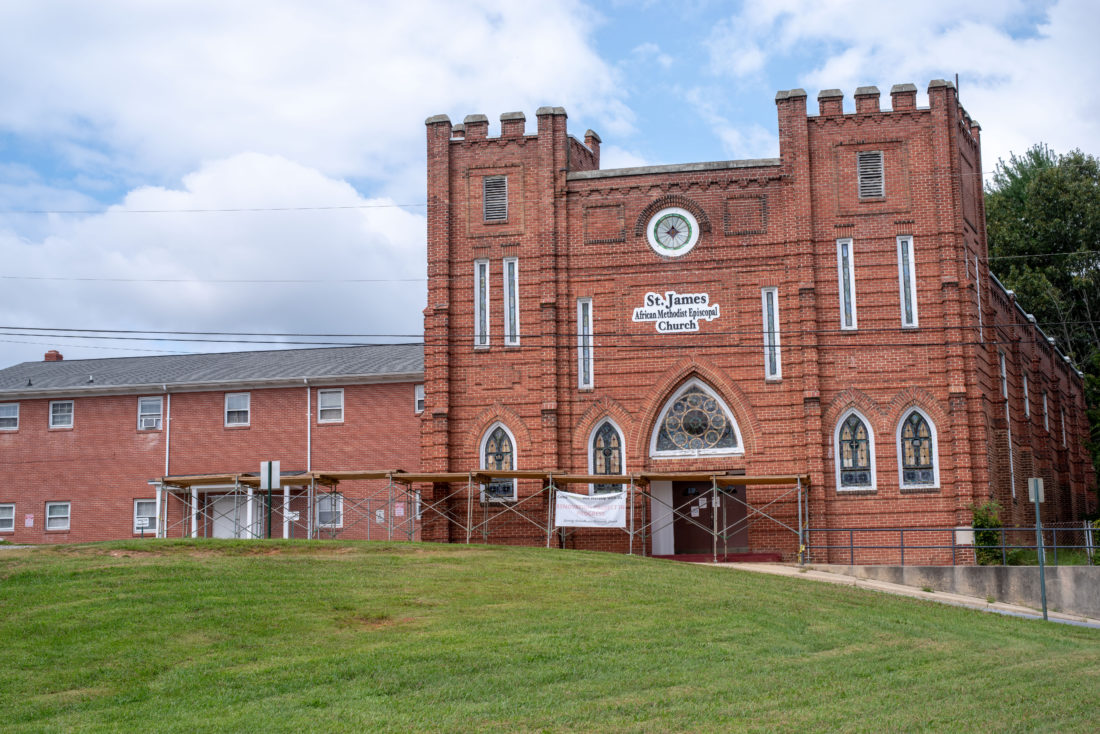The sermon the Rev. Brent La Prince Edwards delivered pandemic-style via conference call to his congregation on Aug. 23 was titled “It’s Renovation Time.” The pastor’s remarks were a call for spiritual restoration, but his message dovetailed neatly with a tangible and timely focus for the members of St. James African Methodist Episcopal Church: the desperate need for repairs and refurbishing of the grand Gothic Revival brick structure that serves as the congregation’s physical home.
The current St. James AME Church building has presided from its hill on Hildebrand Street over Asheville’s predominantly African American East End neighborhood for nearly a century. Although the building has historically been a nexus of community activity and a rallying point for racial unity and social justice events in Asheville, it now sits empty during Sunday morning worship, its façade partially obscured behind a web of fencing and scaffolding.
COVID-19 is partially to blame for the unoccupied pews, of course, as Edwards has joined other local pastors in transitioning his ministry to online platforms while his congregation rides out the pandemic. But the barriers around its exterior walls have been erected to protect congregants and visitors from potential harm as the aging brickwork crumbles.
Even before the coronavirus became a factor, Edwards says, services and other activities had moved from the sanctuary to the fellowship hall for safety’s sake. In fact, January marked the first time in 39 years that the church was unable to host Asheville’s annual Martin Luther King Jr. Peace March and Rally.
“The mortar between the bricks has decayed because of age,” says Edwards. “The way they make bricks now is upgraded, it’s different, so we have to get the whole sanctuary redone.”
The disintegrating bricks have allowed water to seep into interior structures, causing damage to the roof, and the bell towers have started to pull away from the main part of the building. Additionally, sand that was used in installing the floor joists when the church was constructed in 1930 has caused significant erosion and buckling of the carpet-covered, wooden sanctuary floor, necessitating its removal and replacement.
Edwards says that with gatherings now happening virtually, the pandemic offers an opportunity for the church to embark on the massive project without displacing worship services and other events. The plan is to accomplish the repairs and renovations in phases, with Phase 1 addressing the immediate danger of falling bricks and Phase 2 taking on the floor and roof projects. In total, the updates will cost an estimated $571,000, a daunting sum for a congregation of just 190 parishioners.
The church is seeking funding through various avenues, including the international nonprofit Nehemiah Project and a possible partnership with the East End/Valley Street Neighborhood Association. “The rest will come from just local donations so that we can get repairs done,” Bernadette Thompson, church secretary and lifelong member of St. James AME, told Xpress in an interview for this story. Thompson set up a GoFundMe campaign to facilitate local fundraising. Sadly, she died on Sept. 16.
Rock of ages

Although the current building has existed for about 90 years, St. James has been an Asheville institution since 1887, according to Thompson’s detailed research on the church’s history. It first existed as Levy’s or Long’s Chapel in an unused streetcar barn on Biltmore Avenue, then called South Main Street. In 1889, the congregation moved to a building at its current spot on Hildebrand Street and Martin Luther King Jr. Drive, which was then known as Pine Street. At this point, parishioners gave the church its current name.
Several years later, the congregation bought a nearby vacant lot and built a parsonage, which was moved in 1917 to make way for the basement of the new church. (The old church building was remodeled into the St. James Apartments.) Construction of the current church building was led by James Vester Miller, a formerly enslaved master mason, St. James member and founder of Miller and Sons Construction Co.
Miller was known at the time as both a civic leader and employer of some of the best brick masons in Asheville, according to biographical information from the UNC Asheville Ramsey Library archives. His company built many of Asheville’s historic churches and commercial buildings, including Mount Zion Baptist Church, Hopkins Chapel and St. Matthias Episcopal Church as well as the fire and police departments and the post office building on Otis Street.
Years later, a collection of books was donated to the church, prompting the construction of the Haith Educational Building. Dedicated in 1983, the project was led by associate pastor, local builder and Stephens-Lee High School teacher Lacy Haith, assisted by church trustee James Walker. Haith also built many of the houses on Haith Drive near A-B Tech, Thompson points out.
St. James AME is a handsome architectural landmark anchoring Asheville’s historically significant East End community, Edwards notes. “This whole neighborhood is historic, from the top of Martin Luther King Drive on down Valley Street, where Stephens-Lee [Recreation Center] is,” he says. “That whole area was a very strong center for African Americans in Asheville’s history. Now it’s very diverse, which we celebrate.”
‘Bedrock of the community’
Throughout its history, St. James — the only African Methodist Episcopal church west of Morganton — has been central to interfaith and civic programs aimed at maintaining and bettering both the local Black community and Asheville as a whole, according to Thompson. The building has served as the venue for educational health care workshops with the nonprofit Asheville Buncombe Institute for Parity Achievement, which addresses health disparities among people of color. It’s also a regular gathering spot for the Interdenominational Ministerial Alliance, National Alliance of Mental Illness, Gamma Omega Chapter of the Alpha Kappa Alpha Sorority, the Rosa Walker Advancement Initiative and the East End/Valley Street Neighborhood Association, among other organizations.
“The church has also hosted forums for the police and the sheriff’s department and when different shootings have occurred across the nation that have affected communities of color and disenfranchised communities,” Thompson added. “Since we’ve been such an active meeting place and a place of worship, not having it available or in good repair means that it’s not available for community use. So, it really makes a difference for not only the parishioners but for any other organizations that would usually rent or utilize the church for other events.”
Communitywide, youth-focused initiatives are also a priority for the church, says Edwards. He mentions mentoring and anti-bullying programs and a recent STEM project done in partnership with the East End/Valley Street Neighborhood Association that engaged about 50 local children in online science, technology, engineering and math activities.
Edwards characterizes St. James as ecumenical, inclusive and interfaith. He says the congregation nurtures collaborations with the local Jewish community — particularly Temple Beth Ha Tephila — as well as local Methodist and Unitarian churches and nonprofits, including Asheville Buncombe Community Christian Ministry and MANNA FoodBank.
“I think the heartbeat of St James is the community,” he says. “It’s always been a predominantly African American congregation, even though our congregation is mixed now, and I love it. We are now pushing for more diversity — that’s our desire. It has been a bedrock of the community since 1887.”
Place of solace
Thompson remembered St. James as a source of constant strength during the intense upheaval and uprooting that occurred in the 1960s and ’70s with desegregation and Asheville’s urban renewal efforts, which displaced countless Black residents from their homes and drastically altered the roads and landscape of the East End and the city’s other Black neighborhoods.
“Beginning with the Hill Street neighborhood in 1957 as the Cross-Town Expressway was built and moving on to Southside, Stumptown, Burton Street and East End, the fabric of each of these historic African American communities was torn apart,” wrote UNC Asheville history professor Sarah Judson in a 2010 N.C. Humanities Council publication.
“The church provided some stability during that time,” said Thompson. “I remember how the road went and Martin Luther King Drive was named by one of the members of the church. James Walter spearheaded the renaming of the street at that time, but he actually got the petition signed to name the street after Martin Luther King Jr.”
“When there are instances of problems happening in this community, people come to St. James,” says Edwards. “They find strength and solace here, and also [a space for] planning strategy on how we can become a better community for our own African American brothers and sisters as well as people of all ethnicities.”
Doris Walker, a 25-year member and church steward, points out that many Asheville residents may have experienced that community vibe at St. James through participation in the annual Martin Luther King Jr. Peace March and Rally. The event was held at the church every January for 38 years until 2020, when the need for repairs made it unsafe for crowds.
“That’s really why we thought the city might be interested in knowing what needs we have, because so many people have visited our church through that event,” she says. “That’s one way we feel kindred to everybody in the city is through that program.”
“I remember one year that we did the MLK, we had 3,000 people,” says Edwards, noting that the event draws an average of 2,000 participants annually. “And it was the most diverse crowd. I wish that could have been aired on national television because I think it gave such a sense of hope to see that we can all get along. … To see all of these ethnic groups coming together peacefully under one roof — to me, that is amazing every year.”
As St. James looks for ways to fund its needed repairs, media outlets across the U.S. have spotlighted Asheville for approving a resolution in July that supported community reparations for Black residents and apologized for the city’s historical role in racist practices. Edwards says that as the city forms a new commission to establish recommendations for ways to implement reparations, local African American clergy are being consulted.
“I applaud Asheville for leading the country in that aspect. I feel positive about it, and I’m hoping that it will — and I think it does need to — support churches. The church still is a nucleus in the African American community,” he says. “So, I think if reparations can help the church, in turn, it will be helping the community.”
And he reiterates St. James’ established commitment to supporting and enhancing Asheville as a whole. “We do that without discrimination, and we do that in the spirit of servitude,” he says. “So, giving to St. James is actually giving back to the community because that’s what we do.”



Before you comment
The comments section is here to provide a platform for civil dialogue on the issues we face together as a local community. Xpress is committed to offering this platform for all voices, but when the tone of the discussion gets nasty or strays off topic, we believe many people choose not to participate. Xpress editors are determined to moderate comments to ensure a constructive interchange is maintained. All comments judged not to be in keeping with the spirit of civil discourse will be removed and repeat violators will be banned. See here for our terms of service. Thank you for being part of this effort to promote respectful discussion.